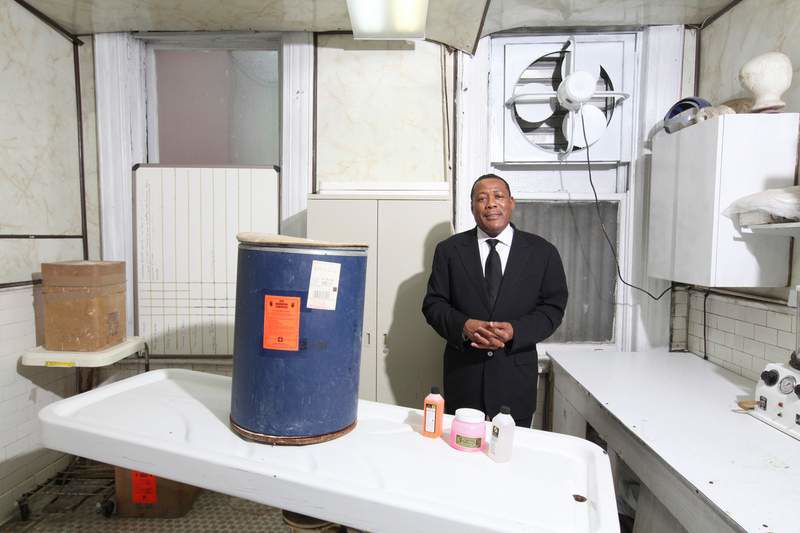Despite cancer risk, embalmers say only formaldehyde will do
Published 5:00 am Thursday, July 21, 2011

- Isaiah Owens, a funeral director in Harlem, says newer embalming fluids don't work as well as formaldehyde. “I wouldn't embalm a body that is being shipped overseas” with an alternative,” he said.
With the government declaring formaldehyde a carcinogen, these might be boom times for alternative embalming fluids — if it weren’t for the so-called everlasting effect every funeral director stakes his reputation on.
“Formaldehyde is the perfect product for fixation and short-term preservation,” said Debbie Dodge, the president of the Dodge Co. in Cambridge, Mass., which markets embalming fluids to funeral homes. “Formaldehyde will firm up the body tissue more than any of the nonformaldehyde products out there.”
The formaldehyde industry fought the government’s designation for years, arguing that the science was fuzzy on the link between the chemical and certain cancers. Consumer advocates hope a government warning in June will spur increased demand for products with little or no formaldehyde — for items as diverse as plywood, pressed wood, wrinkle-free shirts and hair straighteners.
Among funeral directors? Not likely.
Next to arsenic, which is no longer used, undertakers insist nothing else preserves the body long enough so that it is presentable for public viewing and can be shipped. In embalming rooms across the country, the focus is on limiting exposure while still using enough of the chemical to keep the body looking as lifelike as possible.
“Family members,” John Fitch Jr., senior vice president of advocacy for the National Funeral Directors Association, “have a fairly high expectation.”
Changing practices
Undertakers have been aware of formaldehyde’s dangers for more than a decade — the first workplace restrictions on formaldehyde came in the 1980s — and many have been changing their embalming practices to make the process safer.
“In our new facility, the ventilation is very good,” said Michael Lensing, co-owner of the Lensing Funeral and Cremation Service, in Iowa City, Iowa. “In our old facility, oh, my God. It was different.” At the Lensing funeral home, roughly 60 percent of the bodies that come in are embalmed.
Various forms of body preservation have been around for eons, including mummification by the ancient Egyptians. During the Civil War, embalmers prepared the remains of soldiers in the battlefield and shipped them back to their family by train or horse and buggy. A high point, in embalming lore, is that President Abraham Lincoln’s body traveled by train from Washington to Springfield, Ill., with public viewings of the preserved remains along the way.
At that time, arsenic was one of the primary preservatives. It was eventually replaced by formaldehyde.
Modern-day embalming fluid is a mixture of formaldehyde, other less toxic chemicals and water. The embalming fluid that is injected to the arterial system, to replace blood, is up to 5 percent formaldehyde, while a more concentrated form — up to 50 percent formaldehyde — is injected into the body cavity.
An average embalming requires a minimum of three gallons of the embalming solution, said Melissa Johnson Williams, executive director of the American Society of Embalmers.
No good substitute
Dodge’s company began selling embalming fluids without formaldehyde a few years ago, and some companies now market “green burials” in which less toxic chemicals are used. But while the sales of nonformaldehyde products are increasing, she said that as of yet they simply do not work as well and cost nearly three times as much.
The problem is that the new embalming fluids do not give bodies that “everlasting effect,” said Ed Lins, a funeral director at Cross Island Funeral Service, in New York.
“I wouldn’t embalm a body that is being shipped overseas with it,” said Isaiah Owens, who owns a funeral home in Harlem, “It may look perfectly well. But it may be smelling.”
The first major safety improvements in the funeral industry’s use of formaldehyde came in the 1980s after the Occupational Safety and Health Administration set exposure limits for the chemical in the workplace, including mortuaries. Then, about a decade ago, the National Funeral Directors Association met with chemical companies and urged them to come up with alternatives to formaldehyde, Fitch, the association’s senior vice president, said.
Two years ago, the association released a stronger set of recommendations for how its members should deal with formaldehyde. Foremost on the list was installing a proper ventilation system that regularly changes the air in the room and is tested often to make sure it is working properly.
Since formaldehyde is heavier than air, ventilators should be installed below “the breathing zone of the embalmer.” The association also recommends that embalmers wear respirators and nitrile gloves, rather than latex, because they are more resistant to formaldehyde.






